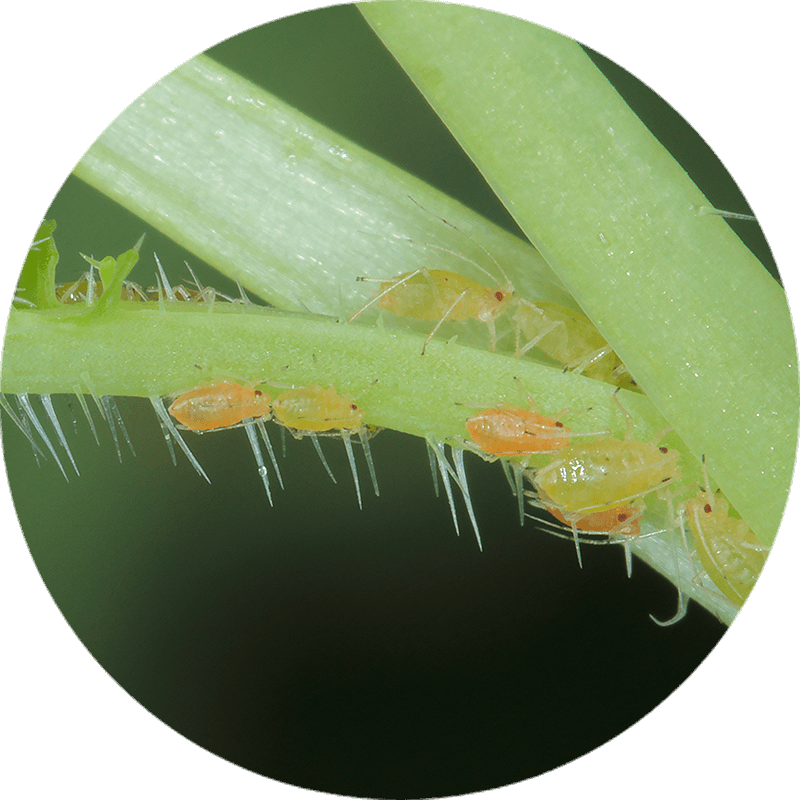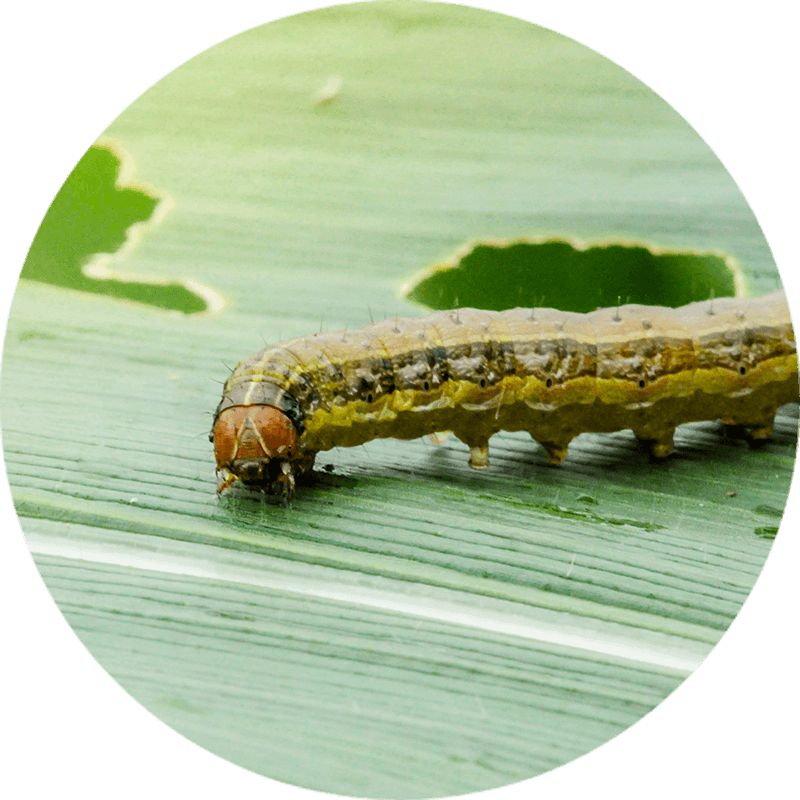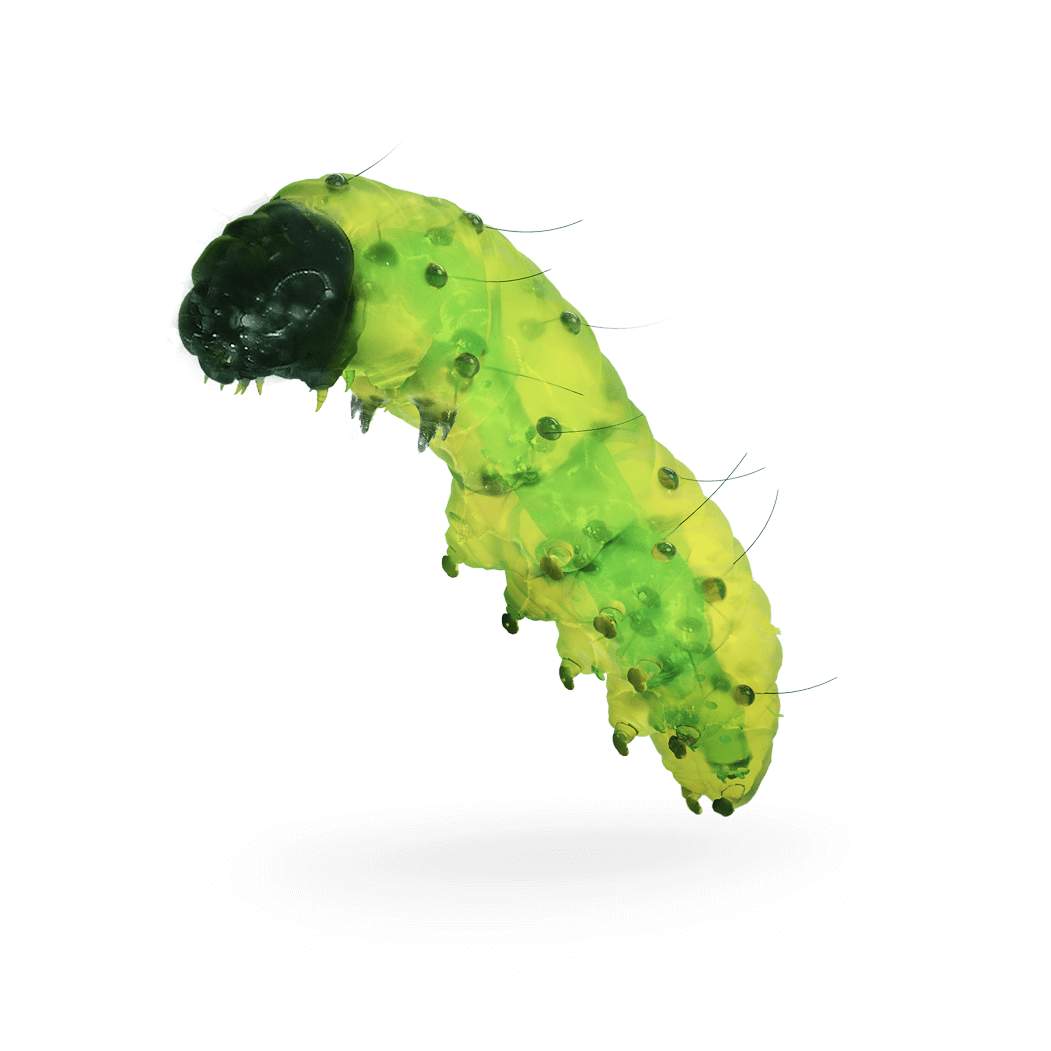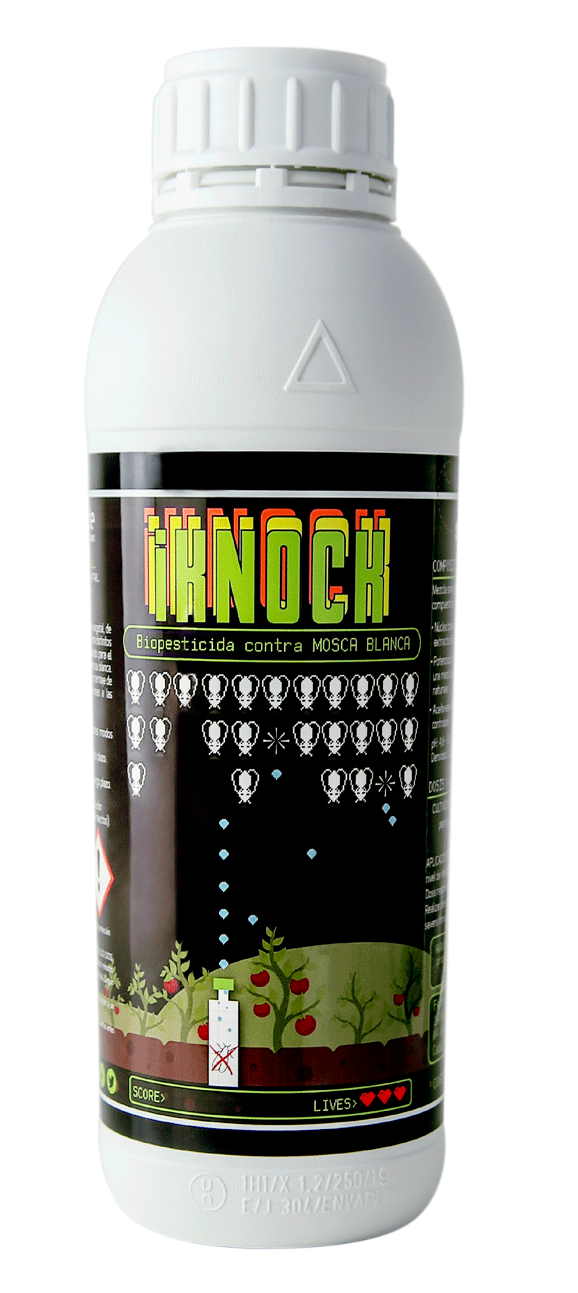
Aphids
Aphids constitute a very large group of insects with great phytophagous activity. The most common and most important aphid species in horticultural crops are Aphis gossypii and Myzus persicae. They are widespread and affect numerous crops.
These are sucking insects that are provided with a long-articulated beak that dig into the vegetable, and by which they absorb the juices of the plant. They secrete a sugary and sticky liquid called molasses, which permeates the surface of the plant preventing its normal development.
-
Life Cycle
There is a first period where winged females arrive at the crop at the end of April-first of May. From this moment they multiply, without forming dense colonies, and tending to spread throughout all the plants; They have a special predilection for the underside of the leaves, where they suck the sap while injecting the viruses they carry. The end of this period coincides with the rise in maximum temperatures over 35ºC. A second attack may occur at the end of August or when temperatures fall again.
-
Symptoms
They are polyphagous insects, which produce significant direct and indirect damage to crops. The direct ones are due to the feeding of the adults and the nymphs on the phloem of the plant, causing generalized weakening, which is manifested in a delay in the growth and yellowing of the plant. During feeding, aphids inject saliva containing toxic substances causing deformations of leaves, such as curl and curvatures.
Indirect damage results in the transmission of viruses, as well as the molasses they secrete, which favors the development of the fungus that causes blackness, which reduces the photosynthetic capacity of the plant, as well as the respiration of the plant.

Whitefly - Bemisia tabaci and Trialeurodes vaporariorum
Whitefly, is a group of insects are known that are characterized by infesting the leaves of the main horticultural crops of economic interest. In Spain, the fly species that have been identified giving rise to pests are Bemisia tabaci or “white tomato and tobacco fly”, and Trialuroides vaporariorum or “greenhouse whitefly”.
-
Symptoms
The symptoms associated with whitefly can be of 2 types:
- Due to the molasses they produce and deposit on the leaves as a result of the secretion of the leftover sugar that comes from the sap they suck. The molasses, not only dirties leaves and fruits, but favors the establishment of “negrilla” and reduces the surface of the leaves through which photosynthesis of plants occurs.
- For the transmission of viruses. Due to the feeding mode of the Whitefly, viruses can travel from one plant to another attached to the suction device. In this case, the fly acts as a vector.
-
Infection Cycle
Adult females lay their eggs preferably on the underside of the leaves. When they hatch, larvae of very slow movement appear until they nail their buccal apparatus to anchor themselves in the leaves and complete their development until the pupa stage. Finally, adults emerge, which feed by sucking the sap from the leaves.

Spodoptera littoralis
Spodoptera littoralis is one of the most destructive agricultural lepidoptera pests within its range, it can attack numerous economically important crops throughout the year. The range of guests covers more than 40 plant families. Also known as African cotton leafworm, Egyptian cotton leafworm or Mediterranean Brocade it is a heterogeneous noctuid very common in Africa and Southern Europe.
-
Life Cycle
The noctuid go through four vital stages: egg, larva or caterpillar, pupa and adult. Adults lay eggs on the leaves, walls and other places in the greenhouse, usually in groups, but sometimes separated. The number of eggs varies from a few dozen to more than one hundred. The larva is a caterpillar, they have small hooks at the end of the false legs, by means of which they can be safely seated, and strong jaws.
They live in flowers, developing seeds, stems or roots, most of them eat leaves and use their strong jaws to gnaw them to the vigorous central vein. They eat continuously except when they are moving. They grow rapidly, and when they have fully developed, they stop eating and look for a place to pupate. After completing all its stages, the caterpillar weaves a cocoon of silk and pupa inside, buried in the ground.
New adults will lead to future generations, usually 3, although it depends on the weather. In the greenhouse, generations can happen throughout the year. Populations tend to be peak in the fall. The adults appear in spring, mate and the females deposit the eggs grouped preferably on the underside of the leaves. Next, they cover the laying with scales of their abdomen that serve as protection. Eggs hatch and caterpillars begin to feed, gregariously at first.
-
Symptoms
Damages are caused by caterpillars that are highly polyphagous. They feed mainly on the leaves, leading to complete defoliation of the plant; Sometimes, they can attack even the roots. Adults are not usually seen, as they are nocturnal habits. It can also cause damage to seedlings.

Thrips
It is of enormous importance due to the large number of crops it affects. The species, Frankliniella occidentalis, more widely known as “Western Flower Thrips”, is a sucking insect of the order Thysanoptera (Thripidae), of very small size. They live among the leaves or among the flowers.
The main crops attacked are pepper, eggplant, cucumber, beans, zucchini, watermelon, melon, tomato in the greenhouse, as alternative crops include cotton and fruit trees and causes damage to ornamental plants such as rose or carnation. They mainly infect fruit crops during flowering and when the fruits are young.
-
Life Cycle
F. occidentalis, in its life cycle passes through different stages: egg, larva I, larva II, prepupa, pupa and adult. The females insert the eggs in isolation within the plant tissues, just below the epidermis of the younger soft tissue of leaves, stems, flowers and inside the buds. From the egg emerge the neonatal larvae that immediately begin their feeding in the place where they laid, with the development the larvae continue their feeding in refugee places of the leaves, flowers or fruits.
In the following nymphalid stages they stop feeding, passing into a state of immobility that develops preferably in the soil. Since its appearance, adults begin to colonize the upper parts of the plants, having great appetite for the flowers and pollen of these, from which they feed. They only feed causing damage to larvae and adults.
The infestation can begin with the entry of insects into the greenhouse with plant material, more advanced the season adults can enter the greenhouse flying from the outside, they can also hibernate in crevices and other hidden places (with optimal humidity) reappearing at the station next.
-
Symptoms
Damages can be classified as direct or indirect. Direct damage is caused by larvae and adults when itching and sucking the cellular content of the tissues, producing whitish superficial lesions in the epidermis of leaves and fruits, in the form of a silver plate, which later becomes necrotic and can affect all the leaves and cause the death of the plant. The phytotoxic saliva secreted in the diet results in deformations in the meristems, which when the leaf develops in the epidermis appear wrinkling chlorotic spots. In fruits these damages despise the quality.
The female when performing her oviposition causes lesions (gills, pits or bulges) in the plant tissue, where the egg is embedded. If the organ in which the posture is in the growth phase produces a small concavity or prominent wart that reacts to the adjacent tissue, observing a marked whitish halo. If the posture occurs on the flower, there is an alteration in the fertilization process.
Indirect damages are those caused by the transmission of virosis. They have the possibility of being a transmission vector, since it injects saliva and sucks the cellular contents, this insect fundamentally transmits the tomato tanning virus (TSWV), which mainly affects tomato, pepper and ornamentals.
.png)
.png)





